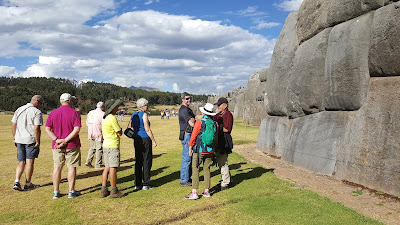Cusco is situated in the Andes at 11,700 feet elevation. This is our first stop as we begin our Machu Picchu adventure.
Cusco was once the capital of the Inca Empire from the 13th until the 16th century Spanish conquest.
We will tour Cusco in the afternoon, drive to the Sacred Valley the next day for one night and then take the train to Aquas Calientes at the base of Machu Picchu where we will spend 2 days before returning to Cusco and then back to Lima and home.
Upon arrival at the airport in Cusco, we try chewing the coca leaves that help us avoid altitude sickness.
Upon arrival at our hotel, we are given tea made from the coca leaves as we wait to check in to our rooms.
We learned the coca comes in a variety of forms and is sold everywhere in this city. We didn't think we would be affected by altitude sickness, but, better safe than sorry!
It is time for lunch, so we head to the Plaza de Armas, the central square in the old city, to find a restaurant.
Actually, the bread baking in this kitchen seemed to draw us in and up to the Cicciolina Bread and Breakfast restaurant above the bakery.
In the afternoon we meet our guide, Juan Gonzalez, for a tour of Cusco and the surrounding area. As we drive out of Cusco, we notice the electrical wires on the outside the buildings....
We first visit the ruins above the city that were considered an essential part of the ancient Incan capital.
We start at Sacsayhuaman, where Inti Raymi, the Festival of the Sun, was held during the Summer Solstice. It is considered to be one of the great works of Inca engineering. The walled complex includes the great plaza used for ceremonial activities and three massive terrace walls built with enormous blocks of stone.
The stones are so closely spaced that a single piece of paper will not fit between many of the stones. This precision, combined with the rounded corners of the blocks, the variety of their interlocking shapes, and the way the walls lean inward is thought to have helped the ruins survive devastating earthquakes in Cusco.
We then stopped at Q'enqo, which is an archeological site that is a reminder of the sacrificial practices and death rituals of the Incas
Q’enqo is a unique temple in its construction, as it’s carved entirely out of a naturally occurring monolith.
We explored the series of man-made caves and tunnels beneath the rock, leading to an altar, indicating that these “secret chambers” were probably used for ceremonial purposes.
We then headed back down to the city of Cusco, taking in the sites of the locals as we passed by in the van.
Our first stop in the main square of Cusco is the Convent and Cathedral of Santo Domingo.
Possibly the most sacred and important building in the entire Inca Empire, Korikancha was the name given to the Inca Temple of the Sun. The colonial structure of the Church and Convent of Santo Domingo sits on top of the original Korikancha foundations.
When the Spanish conquistadores arrived in Cusco, the temple was torn to the ground and its valuable items taken and the present church was built on the site of the temple. Inside some parts of the original temple buildings remain or were reconstructed.
Korikancha - "Kori" meaning gold and "kancha" meaning open ground or place - was dedicated to the worship of the Sun God. The temple itself was lined with solid gold sheets that reflected the sun light, and other golden objects including a solid gold disc studded with precious stones and bearing a human face representing the Sun God.
 |
| Replica of the original Inca sun disc |
Juan enjoyed explaining to us the construction techniques of the Incas. We had a hard time telling which blocks were part of the original construction and which was the restoration.
The wall is aligned closely to the sunrise of the June solstice and includes sun dials.
We then toured the Cusco Cathedral, or the Cathedral Basilica Assumption of the Virgin. It was started in 1560 and took 100 years to complete. It is one of the most important examples of colonial architecture in Latin America.
 |
| The main altar |
The cathedral is the dominant building in the Plaza de Armas.
It was then time to call it a day. We headed for dinner and had our first meal of alpaca.
The next day we head to the Sacred Valley as we make our way toward Machu Picchu.
























































No comments:
Post a Comment